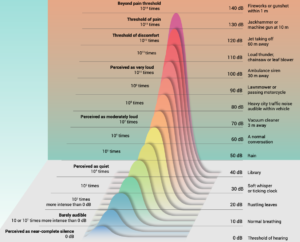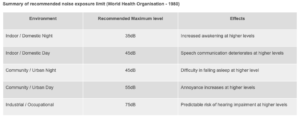ForumIAS announcing GS Foundation Program for UPSC CSE 2025-26 from 19 April. Click Here for more information.
Contents
- 1 Introduction
- 2 What is Noise Pollution?
- 3 What are the key findings of the UNEP’s Frontiers Report on Noise Pollution?
- 4 What are the various causes of noise pollution?
- 5 Why are the harmful impacts of noise pollution?
- 6 What steps have been taken to tackle noise pollution?
- 7 What are the concerns in tackling noise pollution?
- 8 What are the ways to reduce Noise Pollution?
- 9 Conclusion
| For 7PM Editorial Archives click HERE → |
Introduction
UNEP’s Frontiers Report identifies and explores areas of emerging or ongoing environmental concern. The 2022 edition delves into three issues: noise pollution in cities, the growing threat of wildfires and shifts in seasonal events – such as flowering, migration and hibernation, an area of study known as phenology. The report observes that as cities grow, noise pollution becomes a top environmental risk. The report identifies the harmful impacts of noise pollution on environment and human health and proposes some solutions which it recommends to be included in city planning with a view to reducing noise pollution.
What is Noise Pollution?
Unwanted sounds are classified as noise. When noises are too loud and persist too long, they become noise pollution. Noise pollution is generally defined as regular exposure to elevated sound levels that may lead to adverse effects in humans or other living organisms.
Decibels (dB) are the units of measure for indicating the intensity or loudness of a sound. It is a unit for expressing the relative intensity of sound on a logarithmic scale. Since it is a logarithmic scale, even small difference in decibel level indicates orders-of-magnitude difference in intensity of sound e.g., a 60-dB, or 6-bel, sound, such as normal speech, is six powers of 10 (i.e., 106, or 1,000,000) times more intense than a barely detectable sound, such as a faint whisper, of 1 dB.
Source: UNEP Frontiers, 2022
According to the World Health Organization, sound levels less than 70 dB are not damaging to living organisms, regardless of how long or consistent the exposure is. Exposure for more than 8 hours to constant noise beyond 85 dB may be hazardous.
Source: WHO, Vikaspedia
What are the key findings of the UNEP’s Frontiers Report on Noise Pollution?
Delhi, Jaipur, Kolkata, Asansol and Moradabad are the five Indian cities mentioned in the UNEP’s list of cities with maximum noise pollution.
At a maximum value of 114, Moradabad was the second-most-noisiest city in the list. The first was Dhaka, Bangladesh at a maximum value of 119 dB.
Over 72% of Barcelona’s residents are exposed to noise levels of over 55 dB. More than half of the residents of large European cities live in areas where noise levels may adversely affect their health and well-being
Two in five residents of Hong Kong are exposed to road traffic noise above the permissible limit. Residents with lower income and poor housing are more exposed to traffic noise compared to wealthier residents.
The report bases its findings from already published research papers or studies on noise pollution in cities world over. These studies typically involve measurements of levels of noise pollution in different parts of the city: residential areas, industrial areas and commercial places during the day and night.
What are the various causes of noise pollution?
Transportation: A large number of vehicles on roads, airplanes flying over houses, underground trains etc. produce heavy noise. According to the Frontiers Report, across the European Union, at least 20% of citizens are currently exposed to road traffic noise levels that are considered harmful to health.
Industrialization: Many industries use big machines like compressors, generators, exhaust fans, grinding mills etc., which produce a large amount of noise. The 114 dB measurement in Moradabad was an average of measurements reported from a factory in an industrial zone.
Social Events: Noise is at its peak in most of the social events like marriage, parties, pub, disco or place of worship etc. People normally flout rules set by the local administration and create nuisance in the area.
Why are the harmful impacts of noise pollution?
Hearing Loss: Experts believe that regular exposure to over 85 dB for an 8-hour day or longer can cause permanent hearing damage.
Sleeping Disorders: Loud noise can hamper sleeping patterns and may lead to irritation and uncomfortable situations. Sleeping disorders can further disturb the body’s circadian rhythm.
Chronic Health Problems: Noise pollution is a risk factor for the development of cardiovascular and metabolic disorders such as elevated blood pressure, arterial hypertension, coronary heart disease and diabetes. A conservative estimate indicates that long-term exposure to environmental noise contributes to 48,000 new cases of ischemic heart disease and causes 12,000 premature deaths annually in Europe.
Productivity Loss: High levels of noise causes extreme discomfort to workers that adversely impacts their mind and reduces their productivity. This in turn enhances cost of production.
Impact on other species: Traffic and other urban noises disturb and endanger the survival of other species. For instance, Acoustic signals are used in a variety of communication contexts by animals like territory defense, warning of danger, locating or attracting a mate, and caring for offspring. However these functions are severely hindered by noise pollution.
Many species tend to adapt to the pollution by altering their behaviour e.g., modifying their signals by switching their vocal frequency or altering their vocalization timing. However, these adaptations can have unintended consequences (like altered vocalization patterns may be considered less attractive by potential mating partner, therefore affecting reproductive success). These consequences might eliminate them from their habitats, with possible significant ecological implications
What steps have been taken to tackle noise pollution?
Central Pollution Control Board (CPCB): It is mandated to track noise levels, set standards as well as ensure, via the State units, that sources of excessive noise are controlled. The agency has a monitoring system where sensors are installed in major cities and few cities have the facility to track noise levels in real time.
Noise Pollution (Control and Regulation) Rules, 2000: The rules define ambient noise levels for various areas like residential, industrial or commercial places during the day and night time.
Source: Indian Journal of Community Medicine
| Note: According to the Rule 3(5) of The Noise Pollution (Regulation and Control) Rules, 2000, an area comprising not less than 100 metres around Hospitals, Educational Institutions and Courts may be declared (by the State Government) as silence area/zone. There are restrictions on certain activities in the Silence Zones like blowing of horns, bursting of sound-emitting fire crackers or use of sound-emitting construction equipment during night time among others. |
National Green Tribunal: It is a dedicated environmental tribunal that was formulated in 2010. Its primary objective is to expeditiously solve environmental cases including violation of noise pollution norms.
What are the concerns in tackling noise pollution?
Narrow meaning of Sound: Policy makers think of sound only in terms of discomfort, such as transport and industrial noise, rather than investigating how to promote sounds that provide comfort. Natural sounds such as flowing water, birdsong, the wind in the trees etc. are soothing sounds that should be promoted.
Reactive Approach: The government on many occasions has adopted a reactive approach where the primary focus is retroactively reducing noise levels. This approach fails to deliver optimum results as manifested by rising sound levels in cities.
Corruption: Prevalence of corruption is a key reason due to which industries and commercial establishments keep on disrespecting environmental norms. They prefer paying a bribe rather than investing huge amounts of money on sound reduction technologies.
What are the ways to reduce Noise Pollution?
First, the focus should be on adopting novel approaches towards noise pollution. For instance, the UNEP Frontiers 2022 recommends adopting a soundscape approach.
Under this, experts try to look at the issue of urban acoustic environments more holistically, taking a listener-centered perspective. Soundscape planning aims to deliver pleasant acoustic environments that enhance appreciation of places by people.
Second, noise pollution should be considered within a broader range of environmental challenges through integrated policies, particularly for the combination of noise and air pollution. Many countries surveyed by the European Environment Agency report shown better results post integration.
Third, focus should also be placed on enhancing green cover. Vegetation in urban environments can absorb acoustic energy, diffuse noise and reduce street amplification. Apart from this, they help in amplifying natural sounds by attracting urban wildlife. This includes measures like tree belts and ‘green roofs’.
Fourth, Pathway interventions are engineering solutions that obstruct the path of noise from source to receiver by creating a barrier. Both traditional and innovative materials, made from recycled materials such as plastic and car tyres, have proved effective. For instance, Fiberglass from decommissioned wind turbine blades in Denmark have shown a barrier effect reduction of traffic noise levels by 6-7 dB.
Conclusion
Noise pollution is a major environmental problem and is cited as a crucial factor causing risk to health across all age and social groups. Its magnitude and extent is more visible in urban regions, hence a greater focus should be given to them keeping in mind the SDG 11 that calls for creating sustainable cities and communities.







